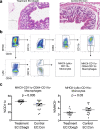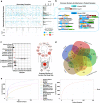Unraveling function and diversity of bacterial lectins in the human microbiome
- PMID: 35661736
- PMCID: PMC9166713
- DOI: 10.1038/s41467-022-29949-3
Unraveling function and diversity of bacterial lectins in the human microbiome
Abstract
The mechanisms by which commensal organisms affect human physiology remain poorly understood. Lectins are non-enzymatic carbohydrate binding proteins that all organisms employ as part of establishing a niche, evading host-defenses and protecting against pathogens. Although lectins have been extensively studied in plants, bacterial pathogens and human immune cells for their role in disease pathophysiology and as therapeutics, the role of bacterial lectins in the human microbiome is largely unexplored. Here we report on the characterization of a lectin produced by a common human associated bacterium that interacts with myeloid cells in the blood and intestine. In mouse and cell-based models, we demonstrate that this lectin induces distinct immunologic responses in peripheral and intestinal leukocytes and that these responses are specific to monocytes, macrophages and dendritic cells. Our analysis of human microbiota sequencing data reveal thousands of unique sequences that are predicted to encode lectins, many of which are highly prevalent in the human microbiome yet completely uncharacterized. Based on the varied domain architectures of these lectins we predict they will have diverse effects on the human host. The systematic investigation of lectins in the human microbiome should improve our understanding of human health and provide new therapeutic opportunities.
© 2022. The Author(s).
Conflict of interest statement
The authors declare no competing interests.
Figures





Similar articles
-
Proteome-wide prediction of bacterial carbohydrate-binding proteins as a tool for understanding commensal and pathogen colonisation of the vaginal microbiome.NPJ Biofilms Microbiomes. 2021 Jun 15;7(1):49. doi: 10.1038/s41522-021-00220-9. NPJ Biofilms Microbiomes. 2021. PMID: 34131152 Free PMC article.
-
A rhamnose-binding lectin from Rhodnius prolixus and the impact of its silencing on gut bacterial microbiota and Trypanosoma cruzi.Dev Comp Immunol. 2021 Jan;114:103823. doi: 10.1016/j.dci.2020.103823. Epub 2020 Aug 12. Dev Comp Immunol. 2021. PMID: 32800901
-
Systemic Lectin-Glycan Interaction of Pathogenic Enteric Bacteria in the Gastrointestinal Tract.Int J Mol Sci. 2022 Jan 27;23(3):1451. doi: 10.3390/ijms23031451. Int J Mol Sci. 2022. PMID: 35163392 Free PMC article. Review.
-
Carbohydrate-binding proteins (plant/human lectins and autoantibodies from human serum) as mediators of release of lysozyme, elastase, and myeloperoxidase from human neutrophils.Res Exp Med (Berl). 1995;195(3):153-62. doi: 10.1007/BF02576784. Res Exp Med (Berl). 1995. PMID: 8570910
-
Microbial lectins as a potential therapeutics for the prevention of certain human diseases.Life Sci. 2024 Jun 1;346:122643. doi: 10.1016/j.lfs.2024.122643. Epub 2024 Apr 15. Life Sci. 2024. PMID: 38614308 Review.
Cited by
-
Phenylboronic Acid-Modified Polyethyleneimine: A Glycan-Targeting Anti-Biofilm Polymer for Inhibiting Bacterial Adhesion to Mucin and Enhancing Antibiotic Efficacy.ACS Appl Mater Interfaces. 2025 Apr 2;17(13):19276-19285. doi: 10.1021/acsami.4c20874. Epub 2025 Mar 18. ACS Appl Mater Interfaces. 2025. PMID: 40099915 Free PMC article.
-
Dietary Nitrogen and Its Role in the Gut Microbiome and Inflammatory Bowel Disease: A Narrative Review.Nutrients. 2025 Jul 20;17(14):2373. doi: 10.3390/nu17142373. Nutrients. 2025. PMID: 40732998 Free PMC article. Review.
-
Chemical tools to study and modulate glycan-mediated host-bacteria interactions.Curr Opin Chem Biol. 2025 Aug;87:102603. doi: 10.1016/j.cbpa.2025.102603. Epub 2025 Jun 4. Curr Opin Chem Biol. 2025. PMID: 40472591 Review.
-
The gut microbiome of Baka forager-horticulturalists from Cameroon is optimized for wild plant foods.iScience. 2024 Feb 10;27(3):109211. doi: 10.1016/j.isci.2024.109211. eCollection 2024 Mar 15. iScience. 2024. PMID: 38433907 Free PMC article.
-
Binding of Akkermansia muciniphila to mucin is O-glycan specific.Nat Commun. 2024 May 29;15(1):4582. doi: 10.1038/s41467-024-48770-8. Nat Commun. 2024. PMID: 38811534 Free PMC article.
References
Publication types
MeSH terms
Substances
Grants and funding
LinkOut - more resources
Full Text Sources

